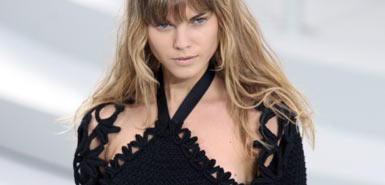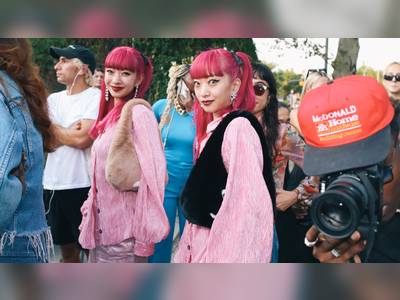Viktor and Rolf, the provocative Dutch duo, feel so encumbered by the market’s voracious demands for something new every few weeks, that the models in their show appeared with the word “No” across their faces — beautifully painted on by expensive make-up artists. In fashion terms this was the equivalent of Prince daubing the word “Slave” on his forehead back in the Nineties.

Chanel
(Francois Guillot/AFP/Getty Images)
But if there’s a dearth of fresh thinking, an underlying theme is emerging — the battle between romantics and radicals. Karl Lagerfeld’s heart belongs in the former camp, however much his brain urges him to radicalize. Intellectually, he can grasp the current move towards stark shapes that swoop away from the body, hence those severe black and white high-necked, white-bibbed cocktail dresses that he dished up yesterday at Chanel. He can do volume, hence his padded silk sheath tops with peplums, matched with knee-length and below skirts. This too was an update — of a pre-First World War silhouette. His tweed suits, with their longer line belted jackets and skirts could have been reworks from the Seventies. And it was all as desirable as ever. That’s the dilemma: make clothes we understand and want or push the envelope and hope to sell enough bags and shoes to take up the financial slack.
Two of the most influential names in fashion now are two of the most radical.
Balenciaga’s Nicholas Ghesquière kicked Paris off with clothes that appeared
to be moulded on a new reading of the human body. Stefano Pilati, the
creative director at Yves Saint Laurent seemed to be working from a similar
start point, although with different results: Ghesquière likes rounded
silhouettes. Pilati the angular.
Rectangular woollen tunics were cut so loosely they swung from the models like canvas from a tent pole. Large-ish jackets and coats, with no visible fastenings, were either belted round the body or cut away in tubular folds. The play on geometry was emphasised by the planes of dark and light grey with the odd sweep of acid yellow or electric blue silk. Ironically the designer who was once the most aggressively modern has turned out to be a romantic. Alexander McQueen’s collection featured Her Majesty’s face against a Union flag ball skirt, chiffon and silk evening dresses that were part sari, part Napoleonic empire line, and ballerina-length, wasp-waisted feathered, strapless dresses inspired by the Fifties. This was a ravishing display, which had McQueen’s usual menace exorcised from it.
A midnight blue, velvet frock-coat with embroidered silver leaves over layers of white tulle skirts was just one of many beautiful future heirlooms, worn with flat, beaded slippers. The New Look homage continued with nipped-in jackets with slight padded hips.
Even the black frock-coats at the beginning, cut narrow and short at the front, with curved tails behind, had a grace sometimes missing from McQueen’s world view. Worn with the leanest of drainpipes, this strict elegance requires death-defying dedication from the wearer.
But what a way to go.













